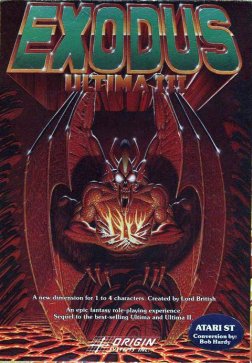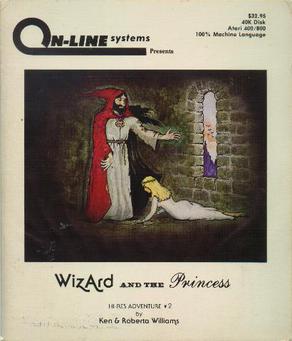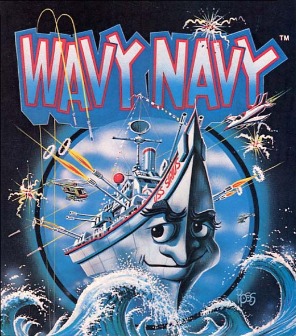
Star Raiders is a space combat simulator video game created by Doug Neubauer and published in 1980 by Atari, Inc. Originally released for the Atari 400/800 computers, Star Raiders was later ported to the Atari 2600, Atari 5200, and Atari ST. The player assumes the role of a starship fighter pilot, who must protect starbases from invading forces called Zylons. Piloting and combat are shown in the 3D cockpit view, while a 2D galactic map shows the state of the Zylon invasion. Neubauer made the game in his spare time at Atari, inspired by contemporary media such as Battlestar Galactica and Star Wars, as well as the 1971 mainframe game Star Trek.

Temple of Apshai is a dungeon crawl role-playing video game developed and published by Automated Simulations in 1979. Originating on the TRS-80 and Commodore PET, it was followed by several updated versions for other computers between 1980 and 1986.

Ultima III: Exodus is the third game in the series of Ultima role-playing video games. Exodus is also the name of the game's principal antagonist. It is the final installment in the "Age of Darkness" trilogy. Released in 1983, it was the first Ultima game published by Origin Systems. Originally developed for the Apple II, Exodus was eventually ported to 13 other platforms, including a NES/Famicom remake.

Autoduel is a role-playing video game published by Origin Systems for the Atari 8-bit computers, Commodore 64, Apple II, and IBM PC compatibles in 1985. It was released in 1987 for the Atari ST and in 1988 for the Amiga and Macintosh. The game is based on the Steve Jackson Games series Car Wars.

Dragonstomper is a video game developed by Stephen Landrum for the Atari Video Computer System and released by Starpath. The game follows the adventures of a dragon hunter who is given a quest by the king to defeat a dragon and reclaim a magical amulet that was stolen. The player makes their way over the countryside, vanquishing various adversaries and gaining gold and experience. After achieving enough strength, the player can enter a shop in an oppressed village where equipment can be purchased, soldiers hired, and special scrolls obtained to defeat the dragon in its lair.

Reach for the Stars is a science fiction strategy video game. It is the earliest known commercially published example of the 4X genre. It was written by Roger Keating and Ian Trout of SSG of Australia and published in 1983 for the Commodore 64 and then the Apple II in 1985. Versions for Mac OS, Amiga, Apple IIGS, and DOS were released in 1988.

The Faery Tale Adventure is a 1987 action role-playing video game designed by David Joiner and published by MicroIllusions for the Amiga, and later ported to the Commodore 64, MS-DOS, and Sega Genesis. The MS-DOS version is titled The Faery Tale Adventure: Book I. Microillusions also released a "Book 1" version for the Amiga which was going to be the start of a series of games, according to Talin, but bankruptcy prevented it. The initial version was produced for the Amiga 1000 and featured the largest game world to that date. A sequel, Faery Tale Adventure II: Halls of the Dead, was released in 1997.

Universe is a science fiction space trading and combat game by Omnitrend Software. It was created by William G M Leslie and Thomas R Carbone. The first version was programmed in valFORTH on an Atari 800, based on a board game created by Leslie. It was Omnitrend's first game.

Space Quest III: The Pirates of Pestulon is a 1989 graphic adventure game by Sierra On-Line, and the third game in the Space Quest series. Players assume the role of Roger Wilco, a lowly space janitor, who becomes involved in rescuing a pair of computer programmers from a sinister video game company. The game received positive reviews from critics, and contributed further to the series' commercial success for Sierra. A sequel, Space Quest IV, was released in 1991.

Moebius: The Orb of Celestial Harmony is a video game produced by Origin Systems and designed by Greg Malone. It was originally released in 1985 for the Apple II. Versions were also released for the Amiga, Atari ST, Commodore 64, Macintosh, and MS-DOS. The game is primarily a top-down view tile-based role-playing video game, but it has action-based combat sequences which use a side view, roughly similar to games such as Karateka.

Telengard is a 1982 role-playing dungeon crawler video game developed by Daniel Lawrence and published by Avalon Hill. The player explores a dungeon, fights monsters with magic, and avoids traps in real-time without any set mission other than surviving. Lawrence first wrote the game as DND, a 1976 version of Dungeons & Dragons for the DECsystem-10 mainframe computer. He continued to develop DND at Purdue University as a hobby, rewrote the game for the Commodore PET 2001 after 1978, and ported it to Apple II+, TRS-80, and Atari 800 before Avalon Hill found the game at a convention and licensed it for distribution. Its Commodore 64 release was the most popular. Reviewers noted Telengard's similarity to Dungeons and Dragons. RPG historian Shannon Appelcline noted the game as one of the first professionally produced computer role-playing games, and Gamasutra's Barton considered Telengard consequential in what he deemed "The Silver Age" of computer role-playing games preceding the golden age of the late 1980s. Some of the game's dungeon features, such as altars, fountains, teleportation cubes, and thrones, were adopted by later games such as Tunnels of Doom (1982).

Worms? is a puzzle video game written by David Maynard for Atari 8-bit computers and ported to the Commodore 64. It was released in 1983 as one of the first publications from Electronic Arts. Worms? is an interactive version of Paterson's Worms.

Wizard and the Princess is a graphic adventure game written for the Apple II and published in 1980 by On-Line Systems. It is the second installment in the Hi-Res Adventures series after Mystery House. Unlike its predecessor, which featured monochrome drawings, Wizard and the Princess introduced color graphics. Ports for the Atari 8-bit computers and Commodore 64 were released in 1982 and 1984 respectively. The 1982 self-booting disk version for IBM PC compatibles was renamed Adventure in Serenia.

Superman is a video game programmed by John Dunn for the Atari Video Computer System and released in 1979 by Atari, Inc. The player controls Superman, whose quest is to explore an open-ended environment to find three pieces of a bridge that was destroyed by Lex Luthor, capture Luthor and his criminal gang, and return to the Daily Planet building. The game world is populated by antagonists such as a helicopter that re-arranges the bridge pieces and roving kryptonite satellites that cause Superman to revert into Clark Kent.

The Cosmic Balance is a game designed by Paul Murray and published in 1982 for the Apple II and Atari 8-bit computers by Strategic Simulations (SSI). It was later released for the Commodore 64. A sequel, Cosmic Balance II, also designed by Paul Murray for SSI, was released in 1983.

3D Space Wars is a space combat video game written by Steve Turner for the ZX Spectrum and published by Hewson Consultants in 1983. It is both the first game written by Turner and the first in the Seiddab Trilogy.

Preppie! is an action video game for Atari 8-bit computers published by Adventure International in 1982. It was programmed by Russ Wetmore of Star Systems Software, whose name is prominently displayed on the box cover. Leaning on the preppy trend of the early 1980s, the game follows prep schooler Wadsworth Overcash as he navigates the hazards of a country club to retrieve golf balls. Preppie! borrows heavily from Konami's Frogger, with lanes of traffic in the bottom half of the screen and a river crossing the top portion. Alligators are an element from both Frogger and preppy fashion; an open-mouthed gator is the icon of shirt brand Izod. Reviewers recognized the game as derivative, but called the music and visuals some of the best for Atari 8-bit computers.

Wavy Navy is a video game designed by Rodney McAuley for the Apple II and published by Sirius Software in 1983. Versions for the Atari 8-bit computers and Commodore 64 were released the same year. Wavy Navy is a nautically themed fixed shooter with left and right controls to move the player's PT boat, but there is an additional vertical element as the boat moves up and down with the large ocean waves that scroll beneath it. The direction and speed of the waves vary per level. Some reviewers found that the movement of the waves added an interesting twist, while others called it too similar to other fixed shooters like Galaxian.

Airstrike is a horizontally scrolling shooter written by Steven A. Riding for Atari 8-bit computers. Having strong similarities to Konami's 1981 Scramble arcade game, it was published in 1982 as the first release from UK-based English Software. In Airstrike, the player flies through caverns while shooting and bombing targets, avoiding terrain, and managing fuel and ammunition. The company described the game as "Very, very, difficult!" in magazine advertisements, and reviewers agreed with that assessment.

Galactic Gladiators is a computer wargame published in 1982 by Strategic Simulations for the Apple II and IBM PC.




















